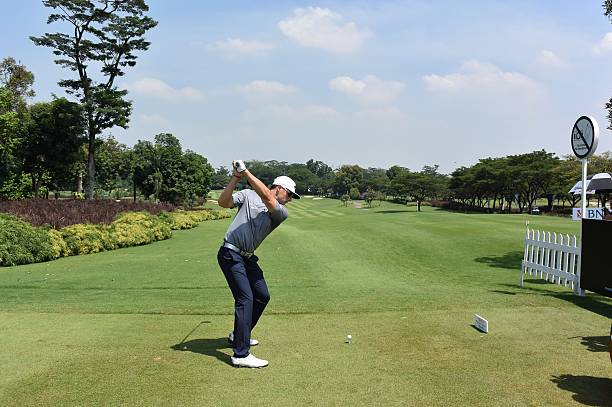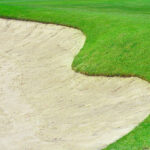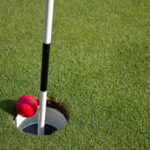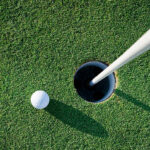Whether you’re a seasoned golfer or a total beginner, it is essential to master the basics of golf such as understanding what is meant by a draw and fade. The ability to control the flight path of your ball when playing golf can greatly improve your game. So in golf what is a draw and fade? In this blog post, we will explore exactly that – explained simply with detailed instructions on how to hit both shot types consistently with ease. Read on to learn more about draws vs fades in golf.
Contents
What Is A Fade In Golf?

A golf fade, also known as a cut shot, is a ball flight that curves from left to right for right-handed players and from right to left for left-handed players. It has the same shape as a slice but is more controlled and doesn’t cover as much lateral distance.
Benefits Of A Fade In Golf
The fade shot in golf is often used to avoid obstacles such as trees or water hazards on the course. It also allows for better control of the ball’s landing spot, making it a useful shot for approaching greens and hitting shorter shots.
Downsides Of A Fade In Golf
One downside of a fade is that it tends to have less distance compared to a draw. This is because the ball has more sidespin, causing it to lose some of its forward momentum. Another disadvantage of a fade is that it can be harder to control in windy conditions. The crosswind can exaggerate the curve of the shot, making it difficult to predict where the ball will land.
When Should You Play A Fade In Golf?
Playing a fade in golf can be beneficial in various situations. One such scenario is when you encounter a hole that doglegs to the right. By utilizing a fade shot, you can effectively cut corners and reduce the overall length of the hole. Additionally, incorporating a fade as your go-to shot can bring consistency to your game, making it a reliable option for many different shots.
How To Hit A Fade In Golf (Simple Method)
- Set up with an open stance: To hit a fade, you need to aim to the left of your target. This means setting up with an open stance, which is when your feet are aimed slightly left of your target line.
- Align your clubface: The clubface should be aimed at your target or slightly right of it.
- Swing along the path of your feet: To create the fade spin on the ball, you need to swing along the path of your feet, which is an out-to-in swing.
- Keep a firm grip: Make sure to keep a firm grip on the club but don’t tense up too much. This will help you control the direction and spin of your shots.
- Follow through: As you come through impact, make sure to follow through with your hands in front of the clubface. This will help produce a controlled and consistent fade shot.
Tip: To improve your fade shots, practice with different clubs and adjust your stance and swing accordingly.
What Is A Draw In Golf?

See more : How Much Are Golf Lessons? Let’s Find Out Golf Lessons
A draw in golf refers to a controlled ball flight that moves slightly right-to-left for right-handed players, or slightly left-to-right for left-handers. This type of shot is the opposite of a fade ball flight, which moves slightly left-to-right for right-handers.
Benefits Of A Draw In Golf
The draw shot in golf is known for its distance and ability to navigate tough fairway positions. It also has a lower trajectory, making it a useful shot in windy conditions.
Downsides Of A Draw In Golf
One downside of a draw in golf is that it can be harder to control compared to a fade. This is because the ball has more backspin, causing it to roll further once it lands. Additionally, if not executed correctly, a draw shot can turn into a hook, which is when the ball curves too much.
When Should You Play A Draw In Golf?
Playing a draw shot in golf can be beneficial in various situations. One such scenario is when you encounter a hole that doglegs to the left. By utilizing a draw shot, you can effectively cut corners and reduce the overall length of the hole. Additionally, a draw shot can also be useful for longer shots as it provides more distance.
How To Hit A Draw In Golf (Simple Method)?
- Set up with a closed stance: To hit a draw, you need to aim to the right of your target. This means setting up with a closed stance, which is when your feet are aimed slightly right of your target line.
- Align your clubface: The clubface should be aimed at your target or slightly left of it.
- Swing along the path of your feet: To create the draw spin on the ball, you need to swing along the path of your feet, which is an in-to-out swing.
- Keep a relaxed grip: Make sure not to grip the club too tightly and maintain a smooth and relaxed swing.
- Follow through: As you come through impact, make sure to follow through with your hands rotating over the clubface. This will help produce a controlled and consistent draw shot.
Tip: To improve your draw shots, practice with different clubs and adjust your stance and swing accordingly.
In Golf What Is A Draw And Fade? Difference Between
See more : What is a birdie in golf? How do you score a birdie in golf?
In golf, a draw and fade refer to two types of ball flights with different spin directions. A draw is a controlled shot that curves slightly right-to-left for right-handed players and vice versa for left-handed players. A fade, on the other hand, is a controlled shot that curves slightly left-to-right for right-handed players and vice versa for left-handers. The main difference between the two is the direction of the spin and the resulting ball flight. A draw has a lower trajectory and more distance, while a fade tends to have less distance but better control.
Which Shot Is Better: A Draw Or A Fade?
There is no definitive answer to which shot is better as it ultimately depends on personal preference and situation. Some players may find a draw shot more reliable and consistent, while others may prefer the control and accuracy of a fade. It is essential to practice both shots and understand when to use each one effectively.
Which Shot Should You Use: Draw Or Fade?
The shot you should use in golf ultimately depends on the situation at hand. Consider factors such as wind direction, hole layout, and personal strengths when deciding between a draw or fade. It is also essential to have both shots in your arsenal and be able to execute them with consistency.
Use Hackmotion To Hit A Draw Or Fade
To hit a draw or fade using the HackMotion swing analyzer, follow these steps:
- Collect baseline data for a straight shot by hitting 10 to 15 shots and observing your wrist angles at impact and the top of your backswing.
- Decide whether you want to hit a fade or a draw. A fade requires a little more extension in the lead wrist, while a draw requires less.
- Set the HackMotion audio feedback to guide you towards the appropriate range for hitting a draw or fade.
- Compare your data to the original straight shot to ensure that you are correctly manipulating your wrists to achieve your desired shot types.
FAQ: Draw Or Fade
What is better a draw or a fade?
A draw tends to roll more than a fade due to its lower backspin. Likewise, a draw generally flies lower and offers better wind penetration compared to a fade. In a headwind, a draw is less likely to “balloon” and will lose less yardage than a fade hit into the same breeze.
How do you remember draw vs fade?
To differentiate between a draw and a fade in golf, it can be helpful to remember the following: a fade starts left of the target and curves right, while a draw starts right of the target and curves back left. Additionally, a golfer can achieve a draw by having an inside-out swing path, hitting the ball from inside the target line, and moving it to the right after impact.
Where do you aim when hitting a draw?
When hitting a draw, the aim is to align to the right (for right-handed golfers). This may seem counterintuitive, but the objective is to initiate an in-to-out swing path. It is crucial to ensure that your shoulders are pointing towards the right.

Jamie Sadlowski is one of the most remarkable golfers in the world. He’s a two-time World Long Drive Champion, and he’s currently ranked 4th in the world. His story is one of perseverance, hard work, and passion for the game. Let’s take a closer look at this inspiring athlete.
The Early Years
Jamie Sadlowski was born in St. Paul, Alberta, Canada. He started playing golf at a young age and quickly developed an affinity for the sport. As he grew older, his passion for golf only deepened and he eventually decided to pursue it as a career. After graduating from high school in 2006, Jamie enrolled at the University of Nebraska-Lincoln where he studied business and played collegiate golf for three years. In 2009, he decided to leave college early to pursue his dream of becoming a professional golfer .








I used to play a draw, which gave me a few extra yards with my longer clubs. However, with draw-shaped approach shots, I found that it was harder to hold greens. I went to the fade and my scores reduced significantly. As an added bonus, the switch also taught me how to properly shape any shot so I can pull a draw, fade, etc. at will.
Draw. If I’m hitting straight I’m trying to hit the ball too hard, so playing a little right of the hole forces me to take a more controlled, ‘firm’ swing, so I can focus on my distance rather than power.
I prefer a fade because I know that, for me, it’s always going to come back where as a draw will either start and stay right or start right and comeback too much.
Thank you for letting me know this information.
Thank you for letting me know this information.
Thank you for letting me know this information.